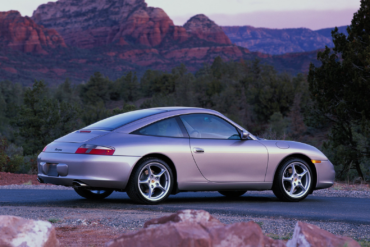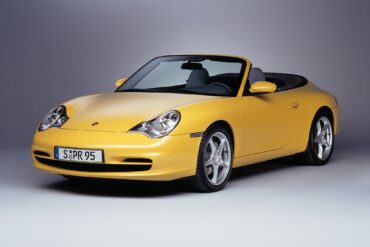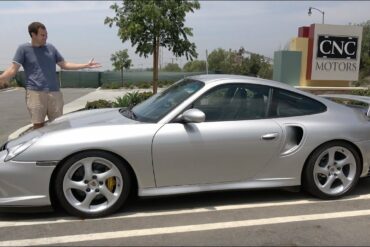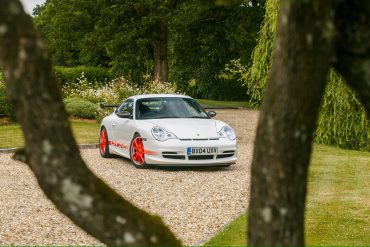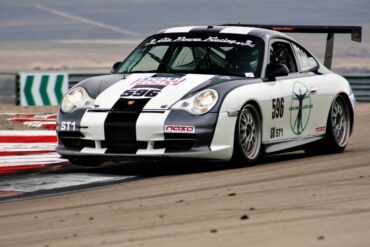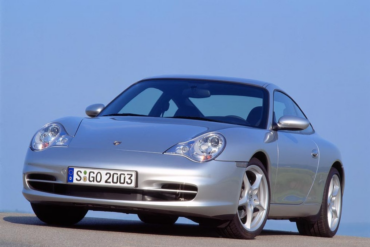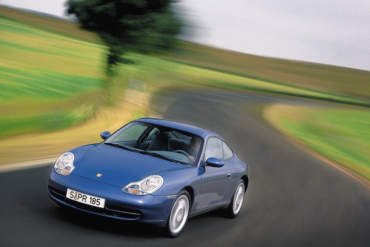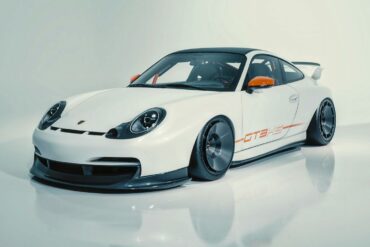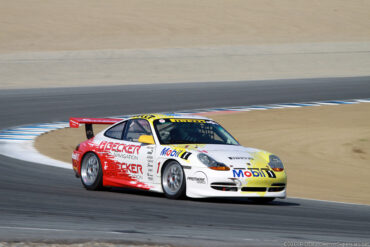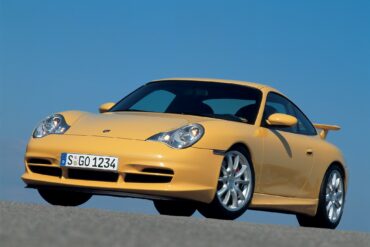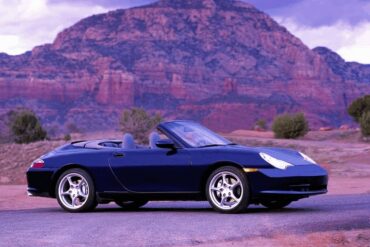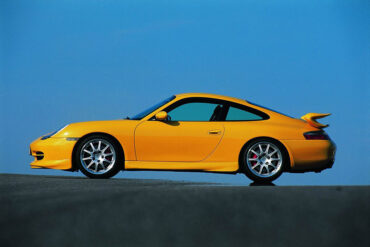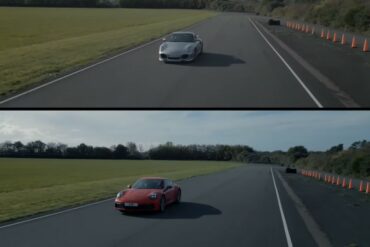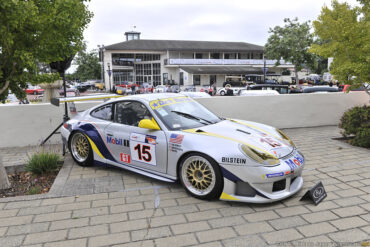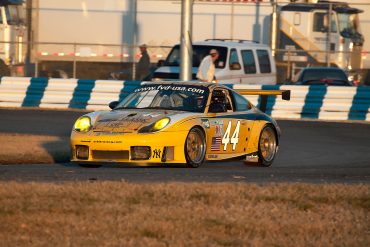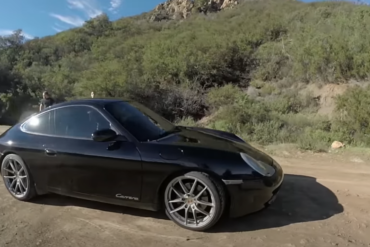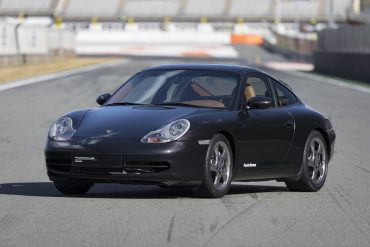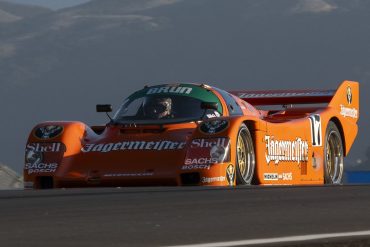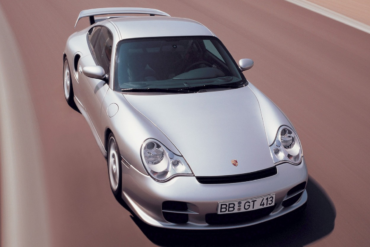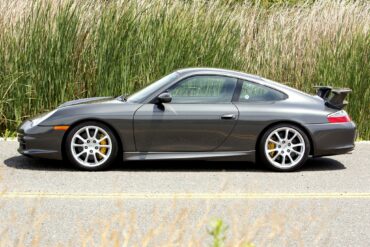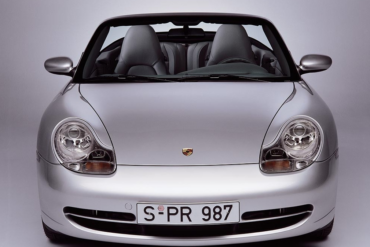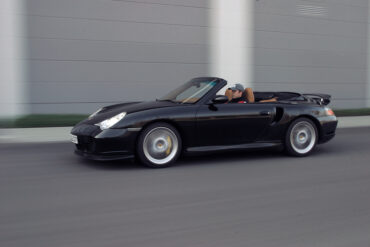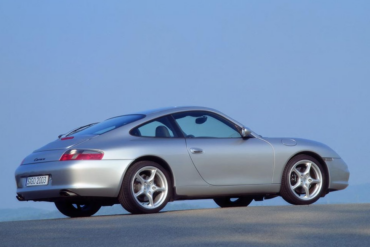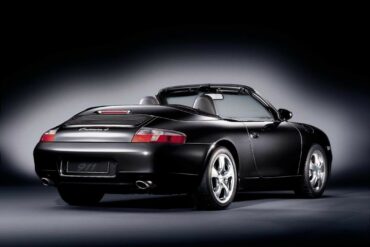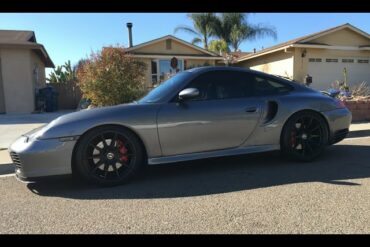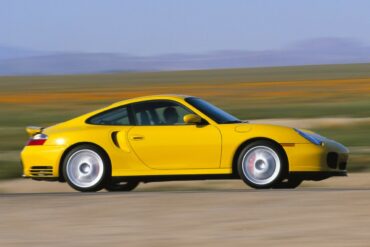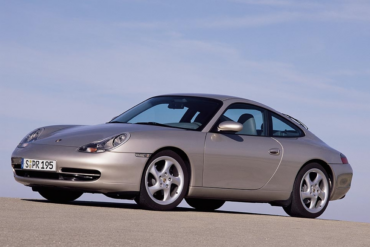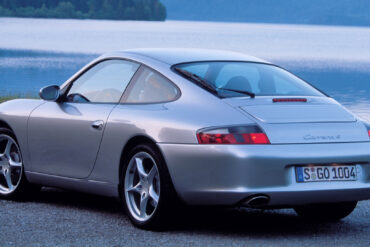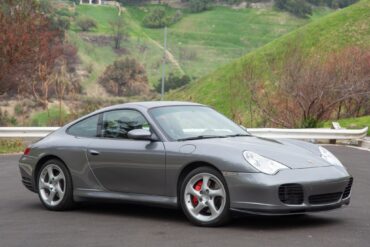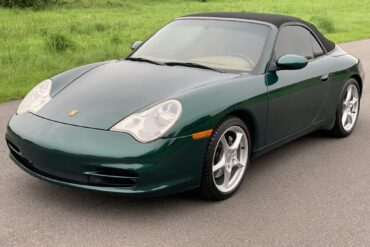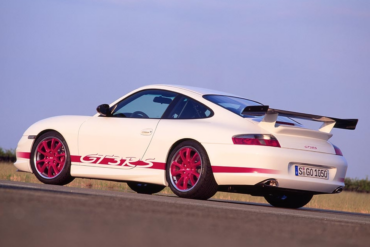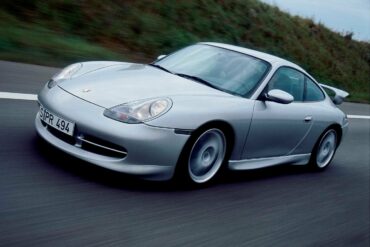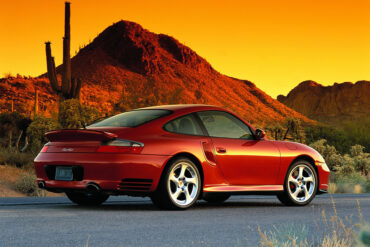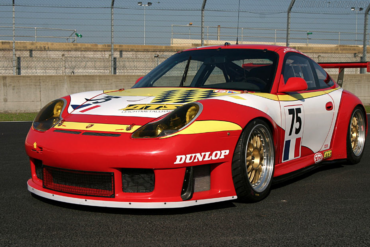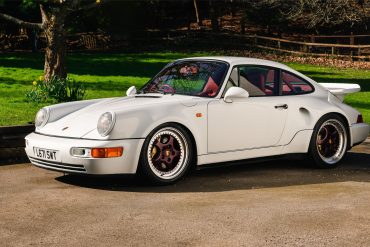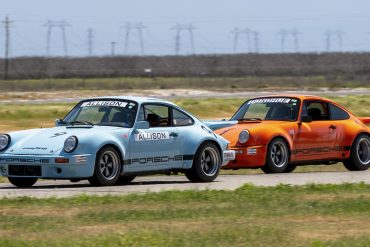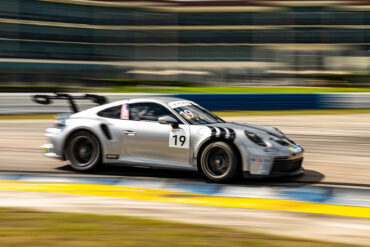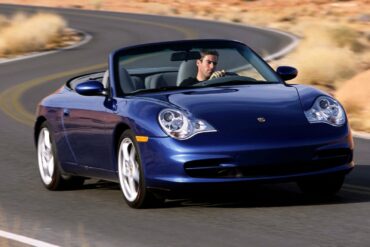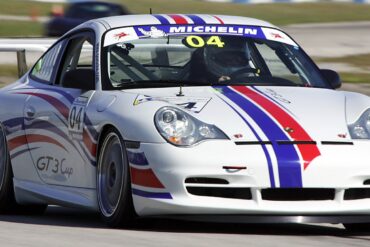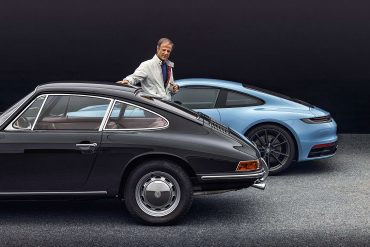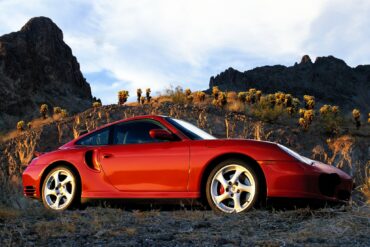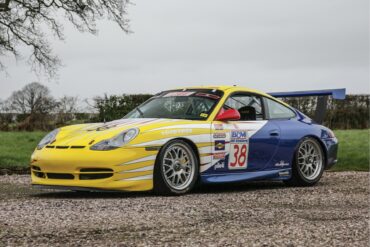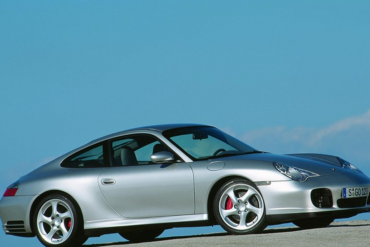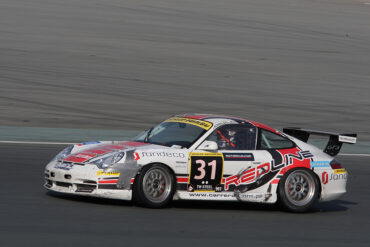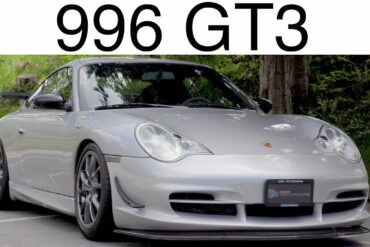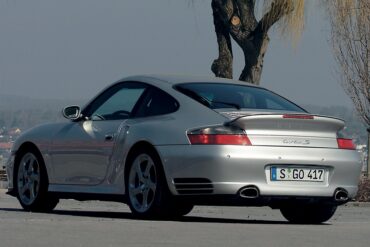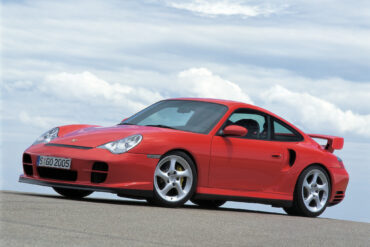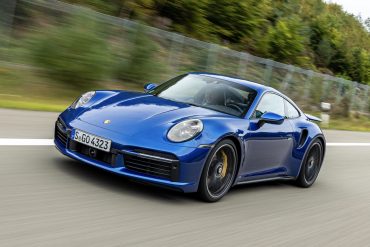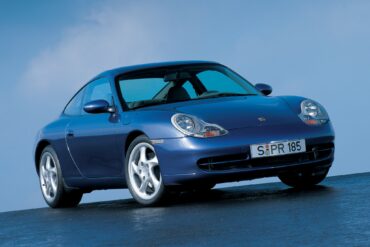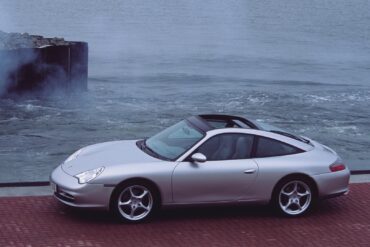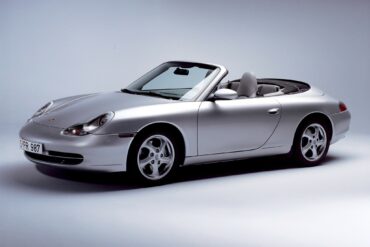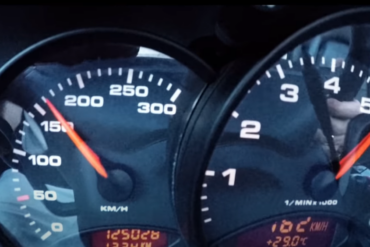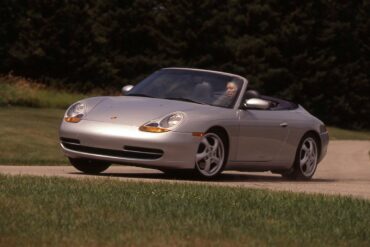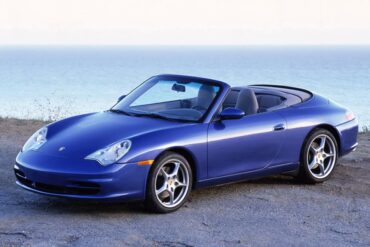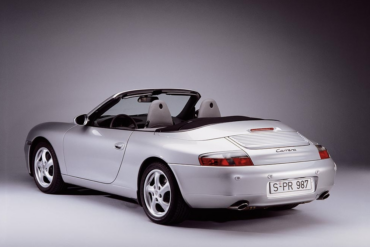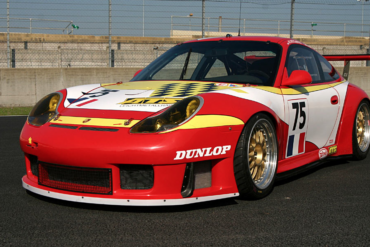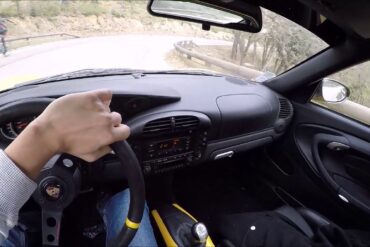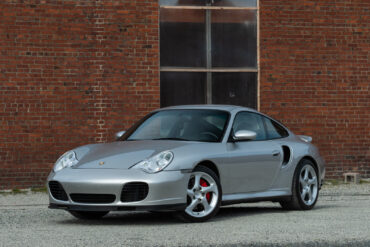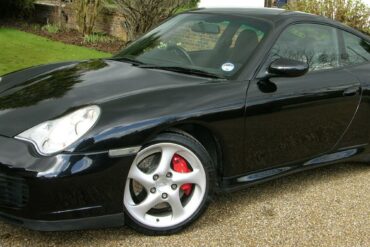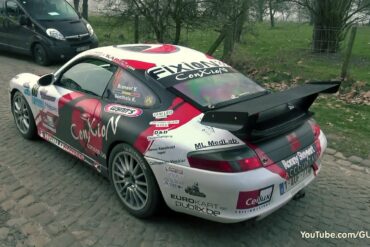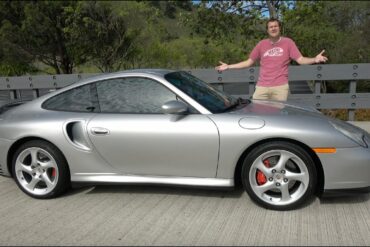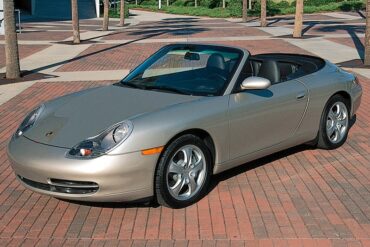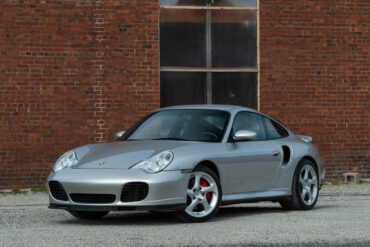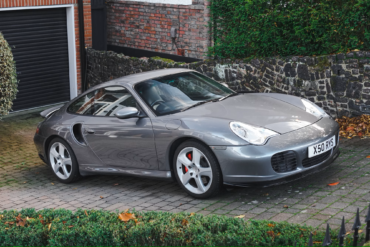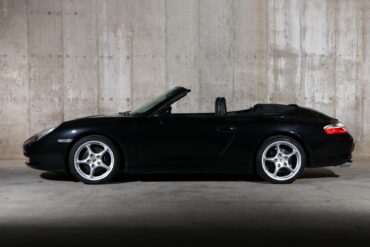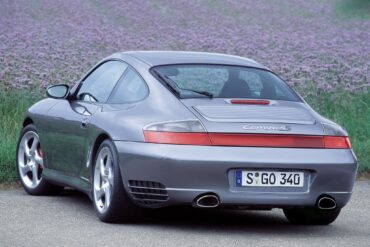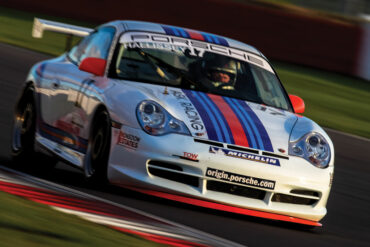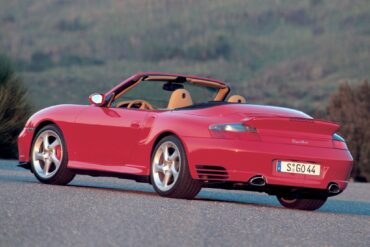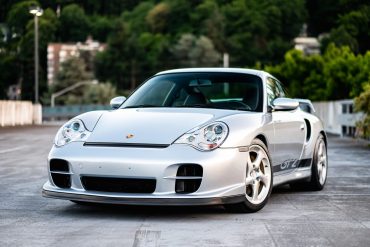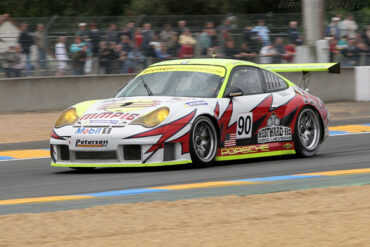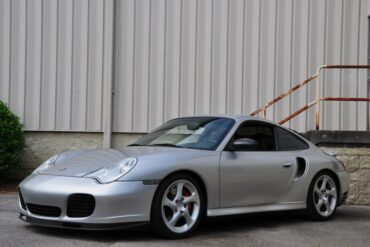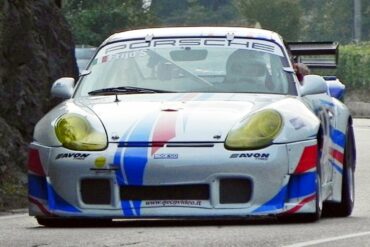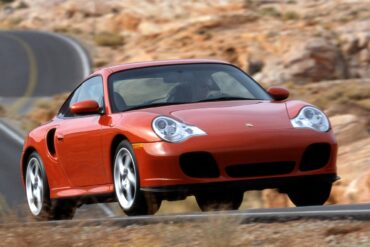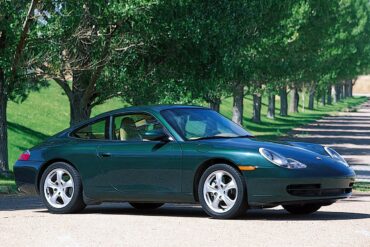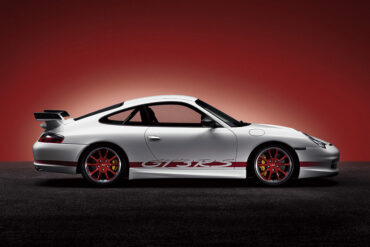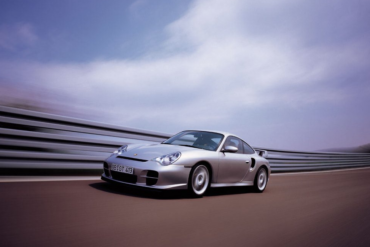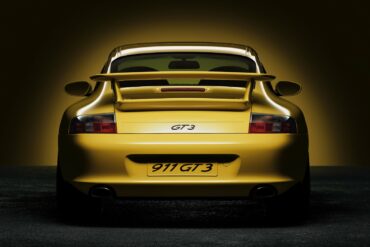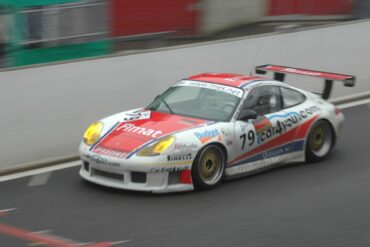2004 Porsche 911 Targa (996) Technical Specifications Engine Type Flat 6 Induction Normally-aspirated Cooling Water-cooled Valvetrain Double overhead camshafts Injection...
Porsche 911 (996)
The introduction of the 911 Model 996 in 1998 ushered in a whole new era for Porsche. Gone was the air-cooled flat six, replaced with an all-new, modern, water-cooled flat-six. The 996 911 was the first redesigned 911 model that didn’t carry over any significant components from it’s predecessors, significant for Porsche at the time as it was known to iterate on the original 911 formula and technology. The 996 was a big deal. It was totally revamped from the inside out. In 1998, the 996 was only offered in coupe and cabriolet versions with either rear-wheel or 4-wheel drive. The Turbo variant appeared in 2001 and came well equipped with a 3.6 L Turbocharged Flat 6 (M96/70), good for 415 bhp. All of the standard models received a minor makeover in 2002 (becoming known as the 996.2 cars), which included Turbo-style headlights, a freshly designed front clip and an increase in engine capacity to 3.6L along with a subsequent 20 hp boost. The bodies were more rigid which further improved handling. See all of our Porsche 996 Research.
2003 Porsche 911 Carrera 4 Cabriolet (996.2) Technical Specifications Engine Type Flat 6 Induction Normally-aspirated Cooling Water-cooled Valvetrain Double overhead...
Doug Demuro Drives the 996 GT2 The 996 Porsche 911 GT2 is my favorite 911 — and today I’m going...
You already read about our preview of The White Collection auction here on Stuttcars. Fifty-five Porsches, mostly in white, with...
Launched in October of 2003, the 996 911 GT3 RS is an extremely sporty model with the power and purist...
2003-2005 Porsche 911 GT3 Cup (996) Technical Specifications Type Racing Car Built at Germany Engine Flat-6 w/Dry Sump Lubrication Position...
In 2002, all of the standard models received a minor makeover in 2002 which included Turbo-style headlights, a freshly designed front clip and an increase in engine capacity to 3.6L along with a subsequent 20HP boost. The bodies were more rigid which further improved handling and safety and the lower, stiffer X74 suspension became available as a factory modification. From the outside, it was hard to notice the difference between the 1998 version and the facelifted model. The main difference was on the headlights. Including the Mk 1 cars, the 996 Carrera Coupe sold 46,317 units.
2000 Porsche 911 Carrera 4 Coupe (996) Technical Specifications Engine Type Flat 6 Induction Normally-aspirated Cooling Water-cooled Valvetrain Double overhead...
Until now, the classic Porsche 911 still attracts a lot of enthusiasts and admirers. And the gorgeous, classic design definitely...
The 996 GT3 Cup served as the basis for the 996 GT3 road car, featuring a 3.6 litre engine with 355 hp. For the 1999 season the engine output was increased to 365 hp. For the 2001 season the GT3 Cup received modified aerodynamics including an enlarged rear wing and improved cooling. For 2002, the GT3 Cup received several changes, adopting facelift 996.2 features such as Turbo-style headlights. The new body significantly improves aerodynamics and cooling. Engine output was increased to 380 hp. For 20003 onward, the power was hiked once again, with the engine now pumping out 385 bhp @ 7250 rpm and of torque 288 ft lbs @ 6500 rpm.
The second generation GT3 takes all that was good about it's predecessor and then improves it! Power from the GT1 derived flat-6 is up by 21 bhp to 381 bhp (with an 8200 rpm redline), ride height is lowered for increased stability and also has an upgraded braking setup, as it features a 6-piston calipers on the front. Two versions are offered, the more extreme 'Clubsport' showing it's track day colors with a full roll cage, racing seat and a 6-point harness. The 996.2 GT3 was the first GT3 marketed in the North America. The new Porsche 911 GT3 comes with all the features of half a century Porsche motorsport. It is a sports car for the purist through and through.
2004 Porsche 911 Carrera 4 Cabriolet (996.2) Technical Specifications Engine Type Flat 6 Induction Normally-aspirated Cooling Water-cooled Valvetrain Double overhead...
2003 Porsche 911 Turbo X50 (996) Technical Specifications Price $ $133,000 Engine Aluminum Alloy, Twin Turbo Flat-6 Position Rear Longitudinal...
2005 Porsche 911 Turbo X50 (996) Technical Specifications Price $ $133,000 Engine Aluminum Alloy, Twin Turbo Flat-6 Position Rear Longitudinal...
The GT3 was based on the standard 996 Carrera, but was stripped of a great deal of equipment for weight savings, featuring stiffer, adjustable suspension and upgraded brakes. The GT3 used the bodyshell of the four-wheel-drive Carrera 4, which incorporated additional front-end stiffening. It featured a naturally aspirated 3.6-litre flat-six engine generating a maximum power output of 360 bhp @ 7200 rpm and torque of 273 ft lbs @ 5000 rpm. This engine was shared with the 996 Turbo and was a derivative of the engine developed for the 911 GT1 race car.
As part of Fifth Gear’s 20th Anniversary, they pit the 20-year-old Porsche 911 Turbo (996) against the 911 Carrera (992)....
400BHP Porsche 911 996 GT3 Clubsport Driven In today’s video I look at an example of the first GT3 –...
The 996 GT3 R was a one-year-only (2000 model year) special of which only 63 were produced. The car took the basic GT3 bones and amplified it for motorsport. The Mezger engine produced over 400 horsepower, while factory-fitted adjustable shock absorbers gave better handling. Most notably, the GT3 R wore carbon-fiber bodywork meant for ultimate light weight in motorsport. The 996 GT3 R was introduced in 1999 as a replacement for the 993 RSR. Before its introduction, it was extensively tested at Weissach and Paul Ricard. In the 2000 FIA GT Championship, the 996 GT3 R was in the N-GT class and won every run. Won the 24-hour race at the Nürburgring.
Almost 60 years after the final race, Solitude Revival from 22 to 23 June 2024 harks back to the motorsport...
The GT3 RS race cars, modeled after the 911 GT3 R, incorporated various technical enhancements to ensure optimal competitiveness on...
2001 Porsche 996 Carrera – One Take This may be the best-bought 996 in history, for under $10,000. So how’s...
Listen to this Porsche 911 996 with x51 package and has been upgraded with Dansk Sport exhaust....
In 1999, Porsche celebrated the turn of the century with a special edition – the 996 "Millennium Edition". The 911 Millennium edition was based on the Carrera 4 coupé and was pretty rare, with only 911 cars made. Based on the Carrera 4, the "Millennium Edition" was limited to 911 examples and was based exclusively on the wide bodied Carrera 4. This special edition was finished in Violet Chromaflair paint, which, depending on the light changes from dark violet to light green and is quite spectacular to look at. It also got a caramel-colored leather interior and polished "turbo-twist" wheels.
If a picture is worth a thousand words, what is a video worth? Enjoy this throwback to 2023’s premier celebration...
2003 Porsche 911 GT2 (996) Technical Specifications Engine Type Flat 6 Induction Twin-turbocharged Cooling Water-cooled Valvetrain Double overhead camshafts Injection...
2004 Porsche 911 Carrera 4 Cabriolet (996.2) Technical Specifications Engine Type Flat 6 Induction Normally-aspirated Cooling Water-cooled Valvetrain Double overhead...
2004 Porsche 911 GT3 (996.2) Technical Specifications Engine Type Flat 6 Induction Naturally Aspirated Cooling Water-cooled Valvetrain Double overhead camshafts...
1999 Porsche 911 Carrera Cabriolet (996) Technical Specifications Engine Type Flat 6 Induction Normally-aspirated Cooling Water-cooled Valvetrain Double overhead camshafts...
2005 Porsche 911 Turbo S Cabriolet (996) Technical Specifications Engine Type Flat 6 Induction Twin-turbocharged Cooling Water-cooled Valvetrain Double overhead...
2003 Porsche 911 Carrera Coupe (996.2) Technical Specifications Engine Type Flat 6 Induction Normally-aspirated Cooling Water-cooled Valvetrain Double overhead camshafts...
2001 Porsche 911 Carrera 4 Cabriolet (996) Technical Specifications Engine Type Flat 6 Induction Normally-aspirated Cooling Water-cooled Valvetrain Double overhead camshafts...
One Take in a Tuned Porsche 996 Turbo X50 The Porsche 996 has sustained a long reputation for reliable speed,...
2001 Porsche 911 Turbo (996) Technical Specifications Engine Type Flat 6 Induction Twin-turbocharged Cooling Water-cooled Valvetrain Double overhead camshafts Injection...
1998 Porsche 911 Carrera (996) Technical Specifications Engine Type Flat 6 Induction Normally-aspirated Cooling Water-cooled Valvetrain Double overhead camshafts Injection...
This 2003 Porsche 911 (996) Turbo received a TechArt upgrade, which includes an enhanced engine, bodywork, and alloy wheels. Its...
Porsche Option Codes – Porsche 911 (2001 Model Year) Looking to decode your 2001 Porsche 911 option codes? Want to...
Porsche Option Codes – Porsche 911 (2002 Model Year) Carrera 3.6/GT3/Turbo/GT2, Coupé/Targa/Cabriolet Looking to decode your 2002 Porsche 911 option...
The Porsche 996 Turbo Is An Under-appreciated Sports Car & Shouldn’t Be I haven’t got to spend much time behind...
Porsche 996.1 v 996.2: Every Detail Revealed The Porsche 996 Carrera is on a crest of a wave in popularity...
2002 Porsche 911 Carrera 4 Cabriolet (996.2) Technical Specifications Engine Type Flat 6 Induction Normally-aspirated Cooling Water-cooled Valvetrain Double overhead...
Better, Or Worse Than Standard? I love the looks of the 996 generation 911 turbo, but the drive of them...
2004 Porsche 911 GT3 RS (996) Technical Specifications Engine Type Flat 6 Induction Naturally Aspirated Cooling Water-cooled Valvetrain Double overhead...
Porsche Option Codes – Porsche 911 (2000 Model Year) Looking to decode your 2000 Porsche 911 option codes? Want to...
Porsche 911 (996) Paint Color Options This post outlines all the color options for the 996 generation Porsche 911 over...
2001 Porsche 911 GT3 RS Race (996) Technical Specifications Type Racing Car Built At Germany Engine Watercooled Flat-6 w/Dry Sump...
Kalmar Automotive, enhancer and restorer of bespoke sports cars and special purpose-built adventure vehicles, has revealed its first water-cooled ‘Adventure...
A perfect parade of pristine Porsche 911’s is set to be a star draw at the Salon Privé Club Trophy...
The 15th Targa California rally recently concluded with most drivers logging 1,000+ miles over the roads “less traveled” of California’s...
Early Beginnings It all began in 1990 with the vehicles built for the Porsche Carrera Cup Deutschland. Since then, the...
2004 Porsche 911 Carrera Cabriolet (996.2) Technical Specifications Engine Type Flat 6 Induction Normally-aspirated Cooling Water-cooled Valvetrain Double overhead camshafts...
996 Carrera Cup Champions & Results Two weeks after the 996 Carrera, the 996 GT3 Cup car was introduced for...
Evolution, not Revolution Since its debut in 1964, the Porsche 911 has epitomized engineering evolution. Conceived by Ferdinand “Butzi” Porsche,...
2004 Porsche 911 Turbo (996) Technical Specifications Engine Type Flat 6 Induction Twin-turbocharged Cooling Water-cooled Valvetrain Double overhead camshafts Injection...
1998 Porsche 911 GT3 Cup (996) Technical Specifications Type Racing Car Built at Germany Engine Flat-6 Displacement 3598 cc /...
2003 Porsche 911 Carrera 4S Coupe (996) Technical Specifications Engine Type Flat 6 Induction Normally-aspirated Cooling Water-cooled Valvetrain Double overhead...
2002 Porsche 911 GT3 Cup (996) Technical Specifications Type Racing Car Built at Germany Engine Flat-6 w/Dry Sump Lubrication Position...
The Perfect Race Car? The Porsche 911 996 GT3 This is a tasteful modified 2004 Porsche 911 GT3. This was...
Porsche 911 996 Turbo Values & Market Analysis Buying a Porsche 911 996 turbo? Then this is the video to...
2005 Porsche 911 Turbo S (996) Technical Specifications Engine Type Flat 6 Induction Twin-turbocharged Cooling Water-cooled Valvetrain Double overhead camshafts...
The Porsche 911 GT2 combines the sporting character of the 996 911 GT3 with the power and straight line performance of the...
To date, 27 different variants make up the current generation of the 911 model line-up. Chatting to its developers at...
Since 1989, the rear-wheel-drive Carrera has always been accompanied by an all-wheel-drive Carrera 4, and the 996 was no different. Overlapping with the last year Carrera 993'S, the 996 Carrera 4 represented two major changes for the venerable 911 lineage: a water-cooled flat-6 engine replaced the air-cooled engine used in the previous 911 model, and the body shell received its first major re-design. Engine was 3.4 L and power was 296 hp featuring a change to an "integrated dry sump" design and variable valve timing.
In 2002, the standard Carrera models underwent a facelift. In addition, engine capacity was also increased to 3.6-litres across the range, with power up slightly on the naturally aspirated models. 2002 also marked the start of the production of the 996 based Targa model, with a sliding glass "green house" roof system as introduced on its predecessor. It also features a rear glass hatch which gave the driver access to the storage compartment. The 996 Targa is the rarest bodystyle in the series – only 5,152 were produced (all Mk.2 generation) between 2002 and 2005.
The flat six in the Carrera 996 was a newly-developed flat-six engine that offered 300 hp. It was mated as standard with a six-speed manual. A 5-speed automatic (Tiptronic) with manual override to shift gears was on the options list. As always, the Carrera 2 was rear-wheel-drive. Designed as a grand tourer, the Porsche Carrera Cabriolet was the base version for the open-top 911 range in 1998. The retractable roof was able to be stowed away in 20 seconds at speeds of up to 50 kph (31 mph), like the rest of the 911 convertible range. With the roof up, the car was tested in the wind tunnel at speeds of up to 338 kph (210 mph).
Hard Acceleration in 996 Carrera Scene taken from Episode 6 of cars moving parts by isaflummi. Acceleration to V-Max on...
Doug DeMuro & The Porsche 996 Most Porsche “purists” hate the 996 model Porsche 911. But they’re wrong — it’s...
Porsche Option Codes – Porsche 911 (1999 Model Year) Looking to decode your 1999 Porsche 911 option codes? Want to...
The 996 was initially available in a coupé or a cabriolet (Convertible) bodystyle with rear-wheel drive, and later with four-wheel drive, utilising a 3.4 litre flat-6 engine generating a maximum power output of 221 kW (300 PS; 296 hp).[7] The 996 had the same front end as the entry-level Boxster. After requests from the Carrera owners about their premium cars looking like a "lower priced car that looked just like theirs did", Porsche redesigned the headlamps of the Carrera in 2002. With the cabriolet, buyers have a choice between this version and the hotter Carrera 4S cabriolet.
1998 Porsche 911 Carrera Cabriolet (996) Technical Specifications Engine Type Flat 6 Induction Normally-aspirated Cooling Water-cooled Valvetrain Double overhead camshafts...
In the 2000 FIA GT Championship, the 996 GT3 R was the dominant racer in the new N-GT class and won every run. In the same year, the factory-supported Phoenix Racing won the 24-hour race at the Nürburgring. In 2001, the modified version, now called the 996 GT3 RS, was used. The vehicle was not only very successful in its class, it also achieved overall victories. Modelled on the 911 GT3 R, the GT3 RS race cars offered a number of technical improvements, which combine to ensure a racing car with optimal competitiveness. 50 racing cars were produced.
The power unit featured in the new Porsche 911 GT2 is a high-performance evolution version of the six-cylinder horizontally opposed...
Awesome POV Drive In a 996 GT3 Clubsport 996 GT3 Clubsport -01. this is a fast drive through some twisty...
Porsche Option Codes – Porsche 911 (2004 Model Year) Looking to decode your 2004 Porsche 911 option codes? Want to...
Porsche Option Codes – Porsche 911 (2003 Model Year) Looking to decode your 2003 Porsche 911 option codes? Want to...
Porsche 996 GT3 Rally Flat 6 Goodness Here is another great video from the Rally of Haspengouw 2013: a Porsche...
Doug DeMuro Reviews the 996 Turbo The Porsche 911 Turbo (996) is an amazing bargain. Today I’m reviewing the 996...
The Porsche 911 is a legendary car, revered for its timeless design, exceptional performance, and exhilarating driving experience. It also...
The 2004 Porsche 911 GT3 RS serves as a homologation model, designed to comply with the new international GT rules...
Test Driving a Porsche 996 Turbo with 700 hp The Porsche 996 Turbo is often dismissed by many – with...
1999 Porsche 911 Carrera 4 Cabriolet (996) Technical Specifications Engine Type Flat 6 Induction Normally-aspirated Cooling Water-cooled Valvetrain Double overhead camshafts...
2004 Porsche 911 Turbo X50 (996) Technical Specifications Price $ $133,000 Engine Aluminum Alloy, Twin Turbo Flat-6 Position Rear Longitudinal...
Collecting Cars is currently offering a low mileage example of a 2004 Porsche 911 Turbo equipped with the optional X50 Performance...
Cheap Dream Daily Driver – The 996 Porsche 911 C4S All-wheel drive, all weather, all season, you buy a Subaru right?...
2003 Porsche 911 Carrera Cabriolet (996.2) Technical Specifications Engine Type Flat 6 Induction Normally-aspirated Cooling Water-cooled Valvetrain Double overhead camshafts...
2005 Porsche 911 Carrera 4S Coupe (996) Technical Specifications Engine Type Flat 6 Induction Normally-aspirated Cooling Water-cooled Valvetrain Double overhead...
2002 Porsche 911 GT3 RS Race (996) Technical Specifications Concept Porsche 911 GT3 RS Single-seated, near-standard race vehicle 2002 Vehicle...
2005 Porsche 911 Turbo Cabriolet (996) Technical Specifications Engine Type Flat 6 Induction Twin-turbocharged Cooling Water-cooled Valvetrain Double overhead camshafts...
The Porsche 911 GT2 combines the sporting character of the 996 911 GT3 with the power and straight line performance of the...
Based on the road-going 996 911 GT3 RS, the GT3 RSR features improvements to its predecessor in all key areas. The vehicle is available in an ACO (Automobile Club de l'Ouest) version for competing in Le Mans and in the American Le Mans Series as well as in a FIA specification. The 911 GT3 RSR features a modified front which improves downforce at the front axle. The 3.6-litre, six-cylinder boxer engine delivers 445 hp at 8,250 revs. Maximum torque is now 405 Nm at 7,200 rpm, with top revs reached at 8,500 (for the FIA specification with two 30.8 mm air restrictors). Race cars never got more exciting than this.
The optional X50 Performance Package gave the base Turbo larger K24 turbochargers and intercoolers, a revised ECU and a quad-pipe exhaust, raising the engine’s output from 415 to 450 bhp and maximum torque from 415 to 457 ft lbs. With power at 450 bhp @ 6000 rpm and torque of 457 ft lbs @ 4400 rpm, the X50 option is a monsters. Porsche engineers achieved the increase in power and performance through modifications to the Turbo charger, the change air cooler, the control units and exhaust system in particular. The base constructions of the manual and automatic transmissions were also improved.
Evo Track Battle in a 996 GT3 vs Cayman GTS The all-new Porsche Cayman GTS could be the best sports...
Turn Up the Volume to the Perfect Flat 6 Screaming Sounds This video is about a couple of Porsche 996...
2002 Porsche 911 Turbo (996) Technical Specifications Engine Type Flat 6 Induction Twin-turbocharged Cooling Water-cooled Valvetrain Double overhead camshafts Injection...
2001 Porsche 911 Carrera 4 Coupe (996) Technical Specifications Engine Type Flat 6 Induction Normally-aspirated Cooling Water-cooled Valvetrain Double overhead...
The 996 GT3 RS was a sharpened version of the Mk.2 GT3, built for track use and it was the homologation model for the GT3 race-car. It was the forbidden fruit for the U.S. and Canadian customers. It was available in a limited number and it was a true track-oriented vehicle. It was based on the GT3 version, but with fewer comfort features and even stiffer suspension. It was the kind of car which could have been taken from the shop and dive into the first race-track. The GT3 was available in white color only, with red or blue inscriptions on its sides. The adjustable rear wing and the “duck-tail” were mounted in the back, to provide better traction on higher speeds. It was fitted with the same engine as the GT3.
2001 Porsche 911 GT2 (996) Technical Specifications Engine Type Flat 6 Induction Twin-turbocharged Cooling Water-cooled Valvetrain Double overhead camshafts Injection...
2005 Porsche 911 GT3 (996.2) Technical Specifications Engine Type Flat 6 Induction Naturally Aspirated Cooling Water-cooled Valvetrain Double overhead camshafts...
2003 – 2004 Porsche 911 GT3 RS Race (996) Technical Specifications Concept Porsche 911 GT3 RS Single-seated, near-standard race vehicle...
James takes out this low mileage 996 GT3 RS, currently live on Collecting Cars, to discover how it differs from...


